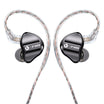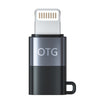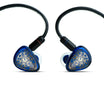Beginner's Guide
Why you need an amplifier for your Headphone or IEM?
An amplifier is a crucial component in any audio system, serving the purpose of
boosting the signal from the source and driving it through your IEMs or headphones. While some devices have built-in amplifiers, they are often limited in power and performance, especially when it comes to driving high-impedance headphones or demanding IEMs. Today we are going to try and help you think about this the right way with this particular video and help you decide that for yourself.
Intro
Hi guys, this is Raghav from Headphone Zone. Do you really need a headphone amplifier to go along with your brand new headphones or in-ear monitors? I'm going to try and help you think about this the right way with this particular video and help you decide that for yourself.
Why You Need an Amplifier for Your Headphone or IEM
Now, with most headphones and IEMs which are out there, you'll find that people just tend to plug them into your smartphone or your laptop and hit play, and they can sound reasonably loud. Typically, these are headphones which may have an impedance of 32 ohms. What is impedance? Impedance, simply put, is an electrical term that you may have learned in high school which describes the amount of resistance that is there in an electrical circuit, and in this particular case, simply tells you how much power the headphone needs for it to function at the right level. 32 ohms is pretty much an industry standard, and you'll find that most headphones that you and I may have listened to are at 32 ohms. Let's say this particular headphone gives you 100 dB of power output, which is the sensitivity of the headphone at 32 ohms. 100 dB is pretty loud—you don't really need a headphone going much louder than that, so it's a simple plug-and-play.
There are headphones which use very, very powerful magnets. These are headphones which need a lot more power and therefore may have an impedance that's higher than 32 ohms. So, typically, you will find that these are the kind of headphones that absolutely need a headphone amplifier. Why? Because your smartphone or your laptop simply will not have the adequate power output to be able to drive these headphones properly. Headphone amplifiers' output power can sometimes be measured in milliwatts—so sometimes 100 milliwatts, 200 milliwatts, 500 milliwatts is describing the amount of output power that these headphone amplifiers can give. And typically, the higher the headphone power output, the louder the headphones can get with the same amount of impedance. Another way to think about it is: if you have a headphone which has a high impedance, let's say 300 ohms, now this is a headphone that's going to need a lot of power. So, you want to go for a headphone amplifier that's pretty powerful and is able to drive this. I would typically pick something which is at least 1,000 milliwatts or higher to drive that headphone.
I want to use a very simple example of how to think about this. You have three different headphones from a brand—take, for example, Beyerdynamic. They make the very, very popular Beyerdynamic DT770 Pro in three different variants: 32 ohms for people to use when they're on the go, to plug into the laptop or the smartphones; the 80 ohms, which is really meant for people to use in studios along with professional studio equipment; and 250 ohms, which is really meant for audiophiles who want to sit back and listen to music at the highest quality possible. The idea is using a more powerful driver and therefore can produce higher levels of detail as compared to the 32 ohms variant, and the 250 ohms variant uses the highest possible driver quality and it produces a lot more details as compared to even the 80 ohms. But the trade-off is that the 80 ohms needs a lot more power and therefore needs a headphone amplifier to drive it, and the 250 ohms needs an even higher amount of power and needs the best possible headphone amplifiers to drive it. When you are typically thinking about which headphone to go for, you'll find that audiophile headphones will almost always use high-quality drivers and magnets and therefore should always be paired with a headphone amplifier.
Choosing the Right Amplifier
The right one really depends on the budget that you have in mind and the power output that the headphone needs for it to sound really, really nice. Now, there are some of us which may think of a headphone as sounding loud enough even without using a very powerful amplifier, and this sometimes happens. When you take some of the highest-end headphones that we have—headphones which are really top-grade headphones—and you're plugging them into relatively cheap or relatively low-power-output amplifiers, this is a little bit of a mismatch. The headphones can sound loud, but they will often sound very, very thin, very, very tinny, not very, very natural and full-bodied. And this is a symptom of you simply plugging your headphones into an amplifier that isn't loud enough, that isn't powerful enough.
Here's how you should think about it: a Maruti 800 reaches 100 kilometres an hour, so does a Range Rover. You'll find that both cars reach 100 kilometres an hour, but the Range Rover just gets there effortlessly. You'll find that just a touch on the accelerator and you're at a hundred. A powerful amplifier does that. Headphones can sound loud, but only one sounds effortless—it's the one which has a proper amplifier paired along with it. So, if your headphones are sounding too thin or sounding like the bass is missing, one of the reasons is you're probably not giving it enough power, so consider upgrading your amplifier.
Talking To Us Is Easy
Get in Touch with Our Team directly - We're Here to HelpWrite to Us
Prefer to drop us a line? Our team will get back to you via email within a working day.
Our customer support is available Monday to Friday: 11am - 6pm.
Write to Us
Join the Discussion
We're not the experts on everything, but our community is. Join The Indian Audiophile Forum.
Join community




















































